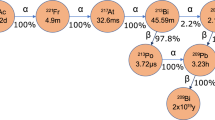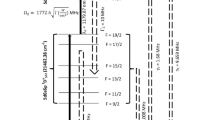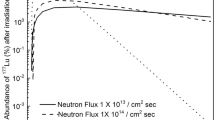Abstract
Enriched isotopes are widely used in medicine, basic science and energy production, and the need will only grow in the future. The main method for enriching stable isotopes today, the calutron, dates back over eighty years and has an uncertain future, creating an urgent need, especially in nuclear medicine. We report here the experimental realization of a general and efficient method for isotope separation that presents a viable alternative to the calutron. Combining optical pumping and a unique magnet geometry, we observe substantial depletion of Li-6 throughput in a lithium atomic beam produced by an evaporation source over a range of flux. These results demonstrate the viability of our method to yield large degrees of enrichment in a manner that is amenable to industrial scale-up and the production of commercially relevant quantities.
This is a preview of subscription content, access via your institution
Access options
Subscribe to this journal
Receive 12 print issues and online access
$209.00 per year
only $17.42 per issue
Buy this article
- Purchase on Springer Link
- Instant access to full article PDF
Prices may be subject to local taxes which are calculated during checkout




Similar content being viewed by others
References
Lawrence, E. & Livingston, M. The production of high speed light ions without the use of high voltages. Phys. Rev. 40, 19–35 (1932).
Love, L. O. Electromagnetic separation of isotopes at Oak Ridge: An informal account of history, techniques, and accomplishments. Science 182, 343–352 (1973).
Yergey, A. L. & Yergey, A. K. Preparative scale mass spectrometry: A brief history of the calutron. J. Am. Soc. Mass Spectrom. 8, 943–953 (1997).
Adelstein, S. J. & Manning, F. J. Isotopes for Medicine and the Life Sciences (National Academies, 1995).
Brown, D. & Harrison, S. Isotope Production and Applications in the 21st Century Production techniques of stable metal isotopes: Current status and future trends. 123–128 (World Scientific Publishing Company, 2000).
Rivard, M. J. et al. The US National Isotope Program: Current status and strategy for future success. Appl. Radiat. Isotopes 63, 157–178 (2005).
Norenberg, J. et al. Workshop on the Nation’s Need for Isotopes: Present and Future. DOE/SC-0107 (US Department of Energy, 2008).
Isotopes for the Nation’s Future: A long range plan. Nuclear Science Advisory Committee: http://science.energy.gov/~/media/np/nsac/pdf/docs/nsaci_ii_report.pdf (2009).
Jerkins, M., Chavez, I., Even, U. & Raizen, M. G. Efficient isotope separation by single-photon atomic sorting. Phys. Rev. A 82, 033414 (2010).
Raizen, M. G. & Klappauf, B. Magnetically activated and guided isotope separation. New J. Phys. 14, 023059 (2012).
Newman, E. Separated Isotopes: Vital Tools for Science and Medicine, The stable isotope enrichment program at Oak Ridge National Laboratory. 45–80 (National Academy, 1982).
Bell, W. & Tracy, J. Stable Isotope Separation in Calutrons: Forty Years of Production and Distribution. ORNL/TM–10356 (Oak Ridge National Laboratory, 1987).
Terry, J. W. Alternative Isotope Enrichment Processes. CONF–8309127–1 (Oak Ridge National Laboratory, 1983).
Kastler, A. Quelques suggestions concernant la production optique et la détection optique d’une inégalité de population des niveaux de quantifigation spatiale des atomes. Application à l’expérience de Stern et Gerlach et à la résonance magnétique. J. Physique Radium 11, 255–265 (1950).
Xiwen, Z., Guilong, H., Ganghua, M. & Delin, Y. Laser isotope enrichment of lithium by magnetic deflection of a polarized atomic beam. J. Phys. B 25, 3307–3314 (1992).
Van Wijngaarden, W. & Li, J. Laser isotope separation of barium using an inhomogeneous magnetic field. Phys. Rev. A 49, 1158–1164 (1994).
Noh, H. R., Kim, J. O., Nam, D. S. & Jhe, W. Isotope separation in a magneto-optical trap. Rev. Sci. Instrum. 67, 1431–1433 (1996).
Kok, K. D. Nuclear Engineering Handbook (Mechanical Engineering Series, Taylor & Francis, 2010).
LeBlanc, D. Molten salt reactors: A new beginning for an old idea. Nucl. Eng. Des. 240, 1644–1656 (2010).
Bruce, G. M., Flack, S. M., Mongan, T. R. & Widner, T. E. Mercury Releases from Lithium Enrichment at the Oak Ridge Y-12 Plant: A Reconstruction of Historical Releases and Off-site Doses and Health Risks. Reports of the Oak Ridge Dose Reconstruction (Tennessee Department of Health, 1999).
Managing Critical Isotopes: Stewardship of Lithium-7 is Needed to Ensure a Stable Supply. GAO-13-716 (United States Government Accountability Office, 2013).
Kusch, P., Millman, S. & Rabi, I. The radiofrequency spectra of atoms hyperfine structure and Zeeman effect in the ground state of Li6, Li7, K39 and K41. Phys. Rev. 57, 765–780 (1940).
Noble, G., Schultz, B., Ming, H. & van Wijngaarden, W. Isotope shifts and fine structures of 6,7LiD lines and determination of the relative nuclear charge radius. Phys. Rev. A 74, 012502 (2006).
Delhuille, R. et al. Optimization of a Langmuir–Taylor detector for lithium. Rev. Sci. Instrum. 73, 2249–2258 (2002).
Gillot, J., Gauguet, A., Büchner, M. & Vigué, J. Optical pumping of a lithium atomic beam for atom interferometry. Eur. Phys. J. D 67, 263 (2013).
The Risks and Benefits of Laser Isotope Separation Federation of American Scientists: http://www.fas.org/policy/debates/20120716/ (2012).
Acknowledgements
The authors would like to thank K. Melin for his contributions to the experiment.
Author information
Authors and Affiliations
Contributions
T.R.M., B.K. and M.G.R. contributed equally to the experiment. All authors discussed the results and commented on the manuscript.
Corresponding author
Ethics declarations
Competing interests
The authors declare no competing financial interests.
Supplementary information
Supplementary Information
Supplementary Information (PDF 1021 kb)
Rights and permissions
About this article
Cite this article
Mazur, T., Klappauf, B. & Raizen, M. Demonstration of magnetically activated and guided isotope separation. Nature Phys 10, 601–605 (2014). https://doi.org/10.1038/nphys3013
Received:
Accepted:
Published:
Issue Date:
DOI: https://doi.org/10.1038/nphys3013
This article is cited by
-
Isotope separation of Potassium with a magneto-optical combined method
Frontiers of Physics (2022)



